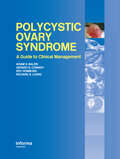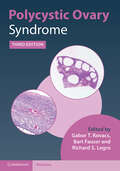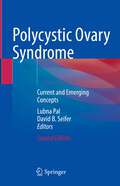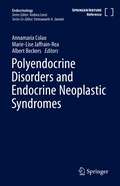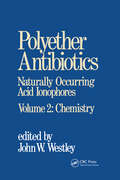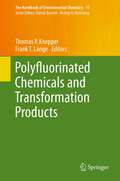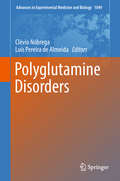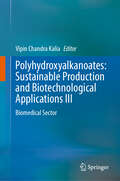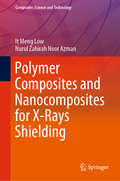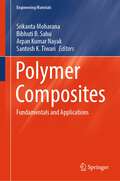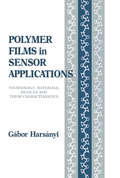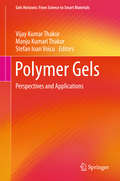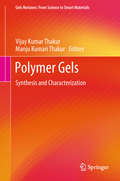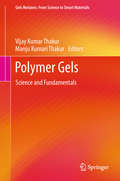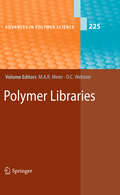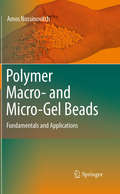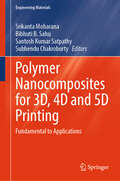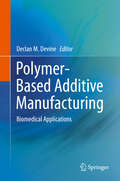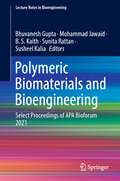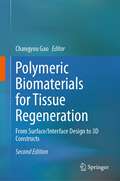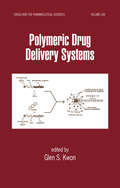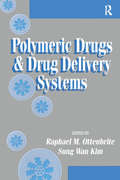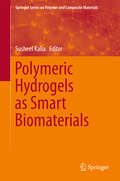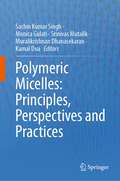- Table View
- List View
Polycystic Ovary Syndrome: A Guide to Clinical Management
by Adam H. Balen Roy Homburg Gerard S. Conway Richard S. LegroClearly presented and thoroughly up to date, this important text provides an overview of current knowledge of the polycystic ovary syndrome (PCOS) - its etiology, pathology, and the implications for effective medical management. In contrast with existing titles, this book focuses on the difficulty in making an accurate diagnosis and the conseq
Polycystic Ovary Syndrome: Current Controversies, From The Ovary To The Pancreas (Contemporary Endocrinology Ser.)
by Richard S. Legro Gabor T. Kovacs Fauser, Bart C. J. M.Polycystic ovary syndrome (PCOS) is one of the most common reproductive health problems of women, causing irregular periods and potential infertility amongst other challenging symptoms. Effective treatment remains a significant challenge and is largely achieved through hormonal medication and lifestyle changes. This third edition covers the aetiology, pathology, impact on fertility and effective medical and surgical management. The content has been thoroughly revised in line with updated guidelines and research developments in the field. A new chapter on the patient's perspective has been included, bringing valuable insight into the lived experience of the condition. Mood disorders and the psychological aspects of PCOS are also covered for the first time. This is a key reference for all clinicians involved in the care of patients with PCOS, including gynaecologists, IVF specialists and reproductive endocrinologists.
Polycystic Ovary Syndrome: Current and Emerging Concepts
by Lubna Pal David B. SeiferNow in a completely newly revised and expanded second edition, this comprehensive text presents the current state of the art in our understanding and management of polycystic ovary syndrome (PCOS), the most common hormonal disorder of reproductive aged women. The numerous bothersome symptoms of PCOS include menstrual irregularities, hirsutism, acne, scalp hair thinning, weigh excess and infertility; additionally, as they age, women with PCOS are at a higher risk for metabolic abnormalities such as diabetes and dyslipidemias, as well as for cardiovascular disease and even certain cancers. Despite improvements in our understanding of this condition, the exact cause/s of PCOS remain elusive; genetic, hormonal, metabolic and environmental underpinnings are all suggested as relevant. All chapters have been updated, with eight new chapters added across seven thematic sections. Part one discusses the epidemiology of PCOS in both adults and adolescents. Part two covers the pathophysiology of PCOS, including genetics, the hypothalamo-pituitary-ovarian and the hypothalamo-pituitary-adrenal axes, insulin resistance, inflammation, and obesity. The next three sections present the various management strategies, medical and surgical, for harnessing the symptomatology, including PCOS-related infertility; these chapters include added case material to provide real-world examples of the treatments in action and their efficacy. Part six covers the comorbidities that women with PCOS commonly encounter, such as issues of mental health, sleep disturbances, endometrial hyperplasia, and cancer, as well as examines the economic burden of PCOS. The final section discusses emerging concepts surrounding possible mechanisms and potential therapeutic approaches to PCOS, including angiogenic dysfunction, the role of vitamin D, future potential therapies to targeted AMH signaling. The closing chapter, by familiarizing the readers with the intergenerational implications of PCOS and by raising awareness of potential “ripple effects”, aims at alerting the community on a need for vigilance as regards the health of PCOS progeny. With contributions from leaders in the field, Polycystic Ovary Syndrome, Second Edition remains the gold-standard text on this common medical condition and a valuable resource for the wide range of healthcare professionals engaged in caring for the women with PCOS (including but not limited to reproductive endocrinologists, gynecologists, family physicians, dermatologists, mental health professionals), for the aspiring women's health providers of tomorrow, and for the researchers who are striving to unravel the mysteries of the complex entity that PCOS is.
Polyendocrine Disorders and Endocrine Neoplastic Syndromes (Endocrinology)
by Annamaria Colao Marie-Lise Jaffrain-Rea Albert BeckersThis comprehensive reference book is meant to support clinicians in the diagnosis and treatment of polyendocrine diseases and endocrine neoplastic syndromes. Although a large majority of endocrine diseases present as sporadic cases, an increasing proportion can be identified as part of a polyendocrine or systemic syndrome. These include autoimmune endocrine diseases, which may be part of autoimmune polyendocrine disorders (APS) or rare complex disorders such as POEMS (polyneuropathy, organomegaly, endocrinopathy, M-protein and skin changes) or IPEX (immune dysregulation, polyendocrinopathy, enteropathy, X-linked) syndromes. On the other hand, endocrine tumors may develop in a variety of clinical conditions, including multiple endocrine neoplasia (MEN) syndromes, syndromic diseases such as McCune Albright or Carney’s complex, or peculiar familial associations such as pheochromocytoma/paraganglioma syndromes. The book discusses the significant advances that have been made in the clinical and genetic characterization of such entities, with major implications in terms of diagnosis and clinical management - with special attention to emerging syndromes, familial screening , multidisciplinarity and multimodal treatment. This volume is intended for clinicians, residents, specialists and physicians involved in the diagnosis and treatment of affected patients, including specialists in endocrinology, internal medicine, oncology , genetics and imaging.
Polyether Antibiotics: Naturally Occurring Acid Ionophores--Volume 2: Chemistry
by J. W. WestleyThis collection of essays will stimulate the use of ionophores in different research areas. It includes information on potential breakthroughs in the halogenated derivatives of lasalocid and ethers of antibiotic A204A, polyethers and analytical techniques used to unravel their complex structures.
Polyfluorinated Chemicals and Transformation Products
by Thomas P. Knepper Frank T. LangeDue to their unparalleled effectiveness and efficiency, polyfluorinated chemicals (PFC) have become essential in numerous technical applications. However, many PFCs brought to market show limited biodegradability, and their environmental persistence combined with toxic and bioaccumulative potential have become a matter of concern in some instances. This volume highlights the synthesis of PFCs, focusing on substances with improved application and environmental properties, which are a challenge for synthetic chemists. Further, modern mass spectrometric techniques for the detection and identification of biotransformation products of PFCs are described. The sorption and leaching behavior of PFC in soil is also addressed in order to predict their fate in the environment. Several contributions discuss the monitoring of PFCs in European surface, ground and drinking waters, treatment options for PFC removal from drinking water, occurrence in food, and the human biomonitoring of PFCs.
Polyglutamine Disorders
by Clévio Nóbrega Luís Pereira de AlmeidaThis book provides a cutting-edge review of polyglutamine disorders. It primarily focuses on two main aspects: (1) the mechanisms underlying the pathologies’ development and progression, and (2) the therapeutic strategies that are currently being explored to stop or delay disease progression. Polyglutamine (polyQ) disorders are a group of inherited neurodegenerative diseases with a fatal outcome that are caused by an abnormal expansion of a coding trinucleotide repeat (CAG), which is then translated in an abnormal protein with an elongated glutamine tract (Q). To date, nine polyQ disorders have been identified and described: dentatorubral-pallidoluysian atrophy (DRPLA); Huntington’s disease (HD); spinal–bulbar muscular atrophy (SBMA); and six spinocerebellar ataxias (SCA 1, 2, 3, 6, 7, and 17).The genetic basis of polyQ disorders is well established and described, and despite important advances that have opened up the possibility of generating genetic models of the disease, the mechanisms that cause neuronal degeneration are still largely unknown and there is currently no treatment available for these disorders. Further, it is believed that the different polyQ may share some mechanisms and pathways contributing to neurodegeneration and disease progression.
Polyhydroxyalkanoates: Biomedical Sector
by Vipin Chandra KaliaThis book provides an in-depth analysis of recent developments in microbial diversity, molecular biology, and biotechnology related to PHA production. PHAs are highlighted as unique biopolymers that are biocompatible, bioresorbable, biodegradable, versatile, and sustainable—qualities that make them strong contenders for various biomedical applications. The chapters cover essential topics such as microbial production of PHAs from biowastes, co-digestion processes to enhance their physio-chemical properties, and challenges related to regulatory approvals and commercialization. Readers will learn about the diverse range of medical applications for PHAs including tissue engineering scaffolds, drug delivery systems, implants, anti-osteoporosis treatments, and memory enhancers. The book also addresses how these biopolymers can be fine-tuned for specific medical uses through advanced bioengineering techniques. Particular attention is given to the potential translation of these technologies into globally competitive business ventures. The volume provides expert analyses on how governmental funding agencies can identify prospective scientific R&D areas. For society at large, this book offers novel concepts about the eco-friendly and economic benefits of PHAs. Researchers in biotechnology, molecular biology, biomedical engineering, and related fields will find this book indispensable. This volume is part of a series dedicated to exploring the vast potential of bioplastics across various sectors. It serves as an essential guide for researchers aiming to achieve sustainable polyhydroxyalkanoate production while addressing critical questions about their practical applications in medicine.
Polymer Composites and Nanocomposites for X-Rays Shielding (Composites Science and Technology)
by It Meng Low Nurul Zahirah Noor AzmanThis book focuses on the processing, materials design, characterisation, and properties of polymer composites and nanocomposites for use as electromagnetic radiation shielding materials and to enhance radiation shielding capacity in order to meet the safety requirements for use in medical X-ray imaging facilities. It presents an in-depth analysis of materials synthesis methods such as melt-mixing, ion-implantation, solution casting and electrospinning. In addition, it measures the X-ray attenuation behaviour of fabricated composites and nanocomposites in four major types of X-ray equipment, namely general radiography, mammography, X-ray absorption spectroscopy and X-ray fluorescence spectroscopy units. Given its scope, the book will benefit researchers, engineers, scientists and practitioners in the fields of medical imaging, diagnostic radiology and radiation therapy.
Polymer Composites: Fundamentals and Applications (Engineering Materials)
by Santosh K. Tiwari Srikanta Moharana Bibhuti B. Sahu Arpan Kumar NayakThis book highlights the fundamentals and recent advances for developing novel polymer composites for various applications, including 3D printing, automotive, textiles, agriculture, nanogenerators, energy storage and biomedical engineering. It presents various facile processing techniques to prepare polymeric composites with attractive properties like mechanical strength, flexibility, thermal & electrical performances for end used applications from bench to field. This in-sight of properties, performances and utility will lead to technological applications of polymer composites. It provides a platform for evolving and expanding technological solutions for challenges in the contemporary world, and presents a concrete path for advancement in this domain of polymer composite for professionals, researchers, material scientists, and students.
Polymer Films in Sensor Applications
by Gabor HarsanyiPolymer films now play an essential and growing role in sensors. Recent advances in polymer science and film preparation have made polymer films useful, practical and economical in a wide range of sensor designs and applications. Further, the continuing miniaturization of microelectronics favors the use of polymer thin films in sensors. This new book is the first comprehensive presentation of this technology. It covers both scientific fundamentals and practical engineering aspects. Included is an extensive survey of all types of sensors and applications. The very detailed table of contents in the next pages provides full information on content. More than 200 schematics illustrate a wide variety of sensor structures and their function.
Polymer Gels
by Vijay Kumar Thakur Manju Kumari Thakur Stefan Ioan VoicuThis book summarizes the recent advances in the science and engineering of polymer-gel-based materials in different fields. It also discusses the extensive research developments for the next generation of smart materials. It takes an in-depth look at the current perspectives and market opportunities while pointing to new possibilities and applications. The book addresses important topics such as stimuli responsive polymeric nanoparticles for cancer therapy; polymer gel containing metallic materials; chemotherapeutic applications in oncology; conducting polymer-based gels and their applications in biological sensors; imprinted polymeric gels for pharmaceutical and biomedical purposes; applications of biopolymeric gels in the agricultural sector; application of polymer gels and their nanocomposites in electrochemistry; smart polyelectrolyte gels as a platform for biomedical applications; agro-based polymer gels and their application in purification of industrial water wastes; polymer gel composites for bio-applications. It will be of interest to researchers working in both industry and academia.
Polymer Gels: Perspectives And Applications (Gels Horizons: From Science To Smart Materials Ser.)
by Vijay Kumar Thakur Manju Kumari ThakurThis book addresses a range of synthesis and characterization techniques that are critical for tailoring and broadening the various aspects of polymer gels, as well as the numerous advantages that polymer gel-based materials offer. It presents a comprehensive collection of chapters on the recent advances and developments in the science and fundamentals of both synthetic and natural polymer-based gels. Topics covered include: synthesis and structure of physically/chemically cross-linked polymer-gels/polymeric nanogels; gel formation through non-covalent cross-linking; molecular design and characterization; polysaccharide-based polymer gels: synthesis, characterization, and properties; modified polysaccharide gels: silica-based polymeric gels as platforms for the delivery of pharmaceuticals; gel-based approaches in genomic and proteomic sciences; emulgels in drug delivery; and organogels. The book provides a cutting-edge resource for researchers and scientists working in various fields involving polymers, biomaterials, bio-nanotechnology and functional materials.
Polymer Gels: Science and Fundamentals (Gels Horizons: From Science to Smart Materials)
by Vijay Kumar Thakur Manju Kumari ThakurThis book exclusively focuses on the science and fundamentals of polymer gels, as well as the numerous advantages that polymer gel-based materials offer. It presents a comprehensive collection of chapters on the recent advances and developments in the core science and fundamentals of both synthetic and natural polymer-based gels, and pays particular attention to applications in the various research fields of biomedicine and engineering. Key topics addressed include: polysaccharide-based gels and their fundamentals; stimuli-responsive polymer gels; polymer gels applied to enzyme and cell immobilization; chitosan-based gels for cancer therapy; natural polymeric and gelling agents; radiation dosimetry; polymeric gels as vehicles for enhanced drug delivery across the skin; transport in and through gel; and polymer gel nanocomposites and functional gels. The book’s extensive and highly topical coverage will appeal to researchers working in a broad range of fields in industry and academia alike.
Polymer Libraries
by Dean C. Webster Michael A. MeierMeier/Webster: General Aspects of Polymer Libraries. - Schubert: Polyoxazoline Libraries and/or the General. - Fasolka: Gradient Methods for Polymer Libraries, Including their Microfluidic Polymerization Methods. - Becker: Bioactive Libraries. - Adams: The Computer-Aided Design of Polymers.
Polymer Macro- and Micro-Gel Beads: Fundamentals and Applications
by Amos NussinovitchThe use of hydrocolloid (water-soluble polymer) beads is on the rise in many fields. A book that covers both past and new applications for hydrocolloid beads, their properties, and how to deliberately change them, is crucial. Currently there are only chapters in a handful of books covering these topics; there are no books fully devoted to them. Water-Soluble Polymer Beads: Fundamentals and Applications fills this void. This book describes all methods of bead production and techniques to change and to estimate their physical and chemical properties. A full description of past and recent developments and applications of beads in the fields of agriculture, biotechnology, environmental studies, medicine and food are presented.
Polymer Nanocomposites for 3D, 4D and 5D Printing: Fundamental to Applications (Engineering Materials)
by Srikanta Moharana Subhendu Chakroborty Bibhuti B. Sahu Santosh Kumar SatpathyThis book presents a guide to polymer nanocomposites for 3D, 4D, and 5D printing, filling the gap between studies and research in the real world, and facilitating its use by engineers, technicians, and designers in their own products and projects. It introduces the reader to cutting-edge 3D, 4D, and 5D printing techniques, as well as the newest innovations in polymer-based printing materials, so that they may reap the benefits of this revolutionary technology. The book covers the fundamentals, methods, materials, and printability concerns involved in preparing polymer composites for 3D, 4D, and 5D printing. Subsequently, the most important applications are described in detail, including electrical, electronic, and biological uses, each of which has its own unique set of design, manufacturing, and processing requirements.
Polymer-Based Additive Manufacturing: Biomedical Applications
by Declan M. DevineThis book aims to give readers a basic understanding of commonly used additive manufacturing techniques as well as the tools to fully utilise the strengths of additive manufacturing through the modelling and design phase all the way through to post processing. Guidelines for 3D-printed biomedical implants are also provided. Current biomedical applications of 3D printing are discussed, including indirect applications in the rapid manufacture of prototype tooling and direct applications in the orthopaedics, cardiovascular, drug delivery, ear-nose-throat, and tissue engineering fields. Polymer-Based Additive Manufacturing: Biomedical Applications is an ideal resource for students, researchers, and those working in industry seeking to better understand the medical applications of additive manufacturing.
Polymeric Biomaterials and Bioengineering: Select Proceedings of APA Bioforum 2021 (Lecture Notes in Bioengineering)
by Susheel Kalia B. S. Kaith Mohammad Jawaid Sunita Rattan Bhuvanesh GuptaThis book presents select proceedings of the APA Bioforum International e-Conference on Polymeric Biomaterials & Bioengineering (APA Bioforum 2021). This book mainly focuses on developing innovative polymeric materials for bioengineering and human healthcare systems. This book helps in the understanding of molecular architecture and its role in governing physical characteristics which is extremely useful to understand the interactions with the biosystem. The topics covered include polymer synthesis, biopolymers, biomaterials, smart materials, nanotechnology, tissue engineering, wound care system, hydrogel, targeted drug delivery, water decontamination and purification. The book will be a valuable reference for beginners, researchers and professionals interested in polymeric materials and biomaterials.
Polymeric Biomaterials for Tissue Regeneration: From Surface/Interface Design to 3D Constructs
by Changyou GaoThis book reviews state of the art of polymeric biomaterials for regenerative medicine and highlights advances in both fundamental science and clinical practice. It summarizes the latest techniques in polymeric scaffold fabrication, delivery carriers, physiochemical property modulation, as well as their influence on the adhesion and performance of biomolecules, cells, and tissues. It also describes methods for creating biofunctional surfaces/interfaces and subsequently modulating the host response to implantable materials. Lastly, it discusses the applications of biomaterials and constructs in soft-tissue regenerative medicine. It is a valuable resource for materials scientists and engineers wishing to identify research priorities to fulfill clinical needs and provides physicians with insights into emerging novel biomaterials. This integrated approach also offers engineering students a sense of the relevance of materials science in the development of novel therapeutic strategies. In the second edition, most of the chapters are updated according to the latest progress of this research field. A new chapter on nerve regeneration is also included.
Polymeric Drug Delivery Systems (Drugs and the Pharmaceutical Sciences)
by Glen S. KwonEmphasizing four major classes of polymers for drug delivery-water-soluble polymers, hydrogels, biodegradable polymers, and polymer assemblies-this reference surveys efforts to adapt, modify, and tailor polymers for challenging molecules such as poorly water-soluble compounds, peptides/proteins, and plasmid DNA.
Polymeric Drugs and Drug Delivery Systems (Acs Symposium Ser. #No. 469)
by Raphael M. Ottenbrite Sung Wan KimPolymeric materials are now playing an increasingly important role in pharmaceuticals, as well as in sensing devices, in situ prostheses and probes, and microparticle diagnostic agents. This new volume consists of twenty-two recent research-based reports on the developments in these areas of pharmaceutical and biomaterials technology. The reports w
Polymeric Gene Delivery: Principles and Applications
by Mansoor M. AmijiTo treat disease or correct genetic disorders using gene therapy, the most suitable vehicle must be able to deliver genes to the appropriate tissues and cells in the body in a specific as well as safe and effective manner. While viruses are the most popular vehicles to date, their disadvantages include toxicity, limited size of genes they can carry
Polymeric Hydrogels as Smart Biomaterials
by Susheel KaliaThis book is concerned with polymeric hydrogels, which are considered as one of the most promising types of new polymer-based materials. Each chapter in this book describes a selected class of polymeric hydrogels, such as superabsorbent hybrid nanohydrogels, conducting polymer hydrogels, polysaccharide-based or protein-based hydrogels, or gels based on synthetic polymers. In this way, the book also addresses some of the fascinating properties and applications of polymeric hydrogels: they are three-dimensional, hydrophilic, polymeric networks that can absorb, swell and retain large quantities of water or aqueous fluids. In combination with metal nanoparticles, nanofibrils or nanowhiskers, which may be embedded in the gels, they find widespread applications, ranging from agriculture, and waste water treatment, over electronics, to pharmaceutical and biomedical applications. Applications mentioned in this book include electro sensors, capacitors, electromechanical actuators, and even artificial muscles.
Polymeric Micelles: Principles, Perspectives and Practices
by Muralikrishnan Dhanasekaran Kamal Dua Sachin Kumar Singh Monica Gulati Srinivas MutalikThis book thoroughly reviews the advancements in design and applications of Polymeric Micelles (PMs) in drug delivery. It provides information on the synthesis of amphiphilic block copolymers and their types, functional chemistry for targeting and sensing, and biomedical applications. The book further provides the possibilities for designing PMs in a range of drug delivery approaches. The book addresses the molecular parameters of amphiphilic block copolymers that are required for functionalizing PMs for drug delivery applications. Additionally, the book presents recent advances in applications of PMs such as co-delivery, sensing, theranostics, delivery of nucleic acids, and proteins. Towards the end, it discusses different physico-chemical strategies to enhance the stability and drug retention of polymeric micelles and reviews the preclinical and clinical toxicity and immunogenicity-related aspects of polymeric micelles. This book is an invaluable source for academics, research, and industry professionals working in the field of polymeric micelles and drug delivery.
